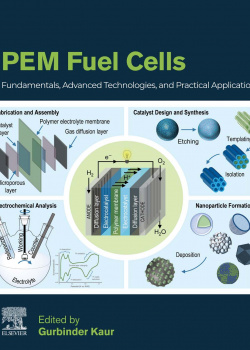

-PEM Fuel Cells Chapter ۱۴ - Automotive applications of PEM technology
-PEM Fuel Cells Chapter 14 - Automotive applications of PEM technology
Green transportation is a fundamental solution to have a considerable reduction in fuel economy, and the amount of air pollutants and greenhouse gas footprint such as CO2, which could make sustainable development in the transportation industry. Proton exchange membrane fuel cell (PEMFC) has been a substitute for internal combustion engines (ICE) in vehicles in developed countries' roadmap. Therefore, the capacity of the installed fuel cell in the transport system has been grown dramatically during recent years. However, there are main drawbacks: cost, durability, and cold start conditions to full commercialization and mass production of PEMFC vehicles. Herein, a complete investigation is presented about the fuel cell vehicles, their current and future status in transportation application. The different fuel cell transport applications, including cars, buses, trucks, forklifts, trains and trams, underwater vehicles, are introduced in sub-section 14.1. The different drive train configurations of conventional internal combustion engine vehicles (ICEV), battery electric vehicles (BEV), hybrid electric vehicles (HEV), and fuel cell vehicles (FCV) are presented and compared with each other in sub-section 14.2. The current market, global shares of the FCVs, and the pioneer manufacturing fuel cell vehicle company are studied and introduced in sub-section 14.3. To have a better insight, the well to wheel CO2 emission and fuel consumption of the ICEVs, BEVs, and FCVs are computed and compared with each other in sub-section 14.4. Also, a complete literature review on well to wheel emission has been presented to investigate the effects of supplying with a different resource of energy, including naphtha, oil, coal, NG, renewable, nuclear as the primary feedstock and the transmission methods from well to tank such as off-site production, transmission by tube trailer or pipeline, and on-site production. The fuel cell manufacturing cost, including the total stack cost and the balance of plant cost, is reported versus different production rates based on the department of energy (DOE) of United States calculations in sub-section 14.5. An economic study is also performed to compute the current (2019) and future (2030) total life cycle cost (LCC) of ICEV, BEV, and FCV with considering the LCCs of vehicle, fuel, and greenhouse gas emissions in sub-section 14.6. PEM automotive applications' latest progress in performance improvement, durability and fuel economy, membrane electrode assembly (MEA) performance and durability improvements, water and heat management, and cold start is presented through a comprehensive literature review in sub-section 14.7. Finally, the latest industrial improvements in FCV which manufacturing companies have made are reported in sub-section 14.8.